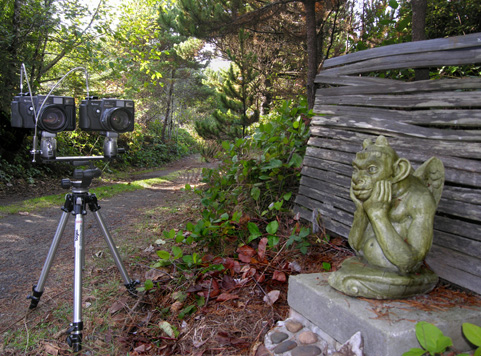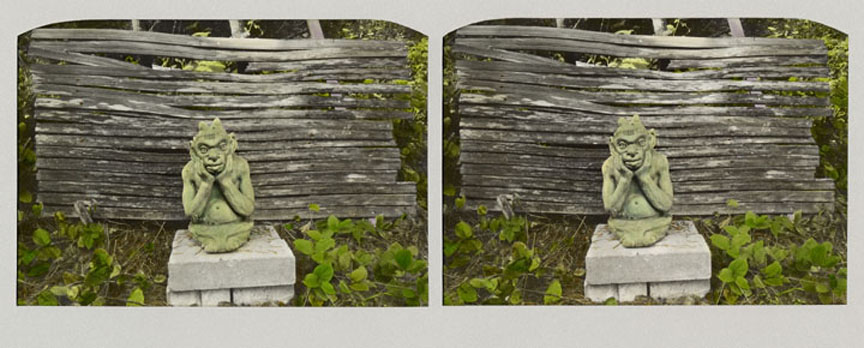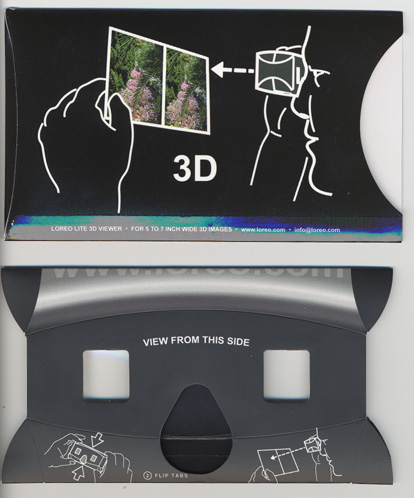| Stereograph Gallery | Home |
On Stereography
 I was walking along the beach last winter, looking up at trees and houses on the
cliff, thinking of nothing in particular, when I was blasted by the
recognition of perspective. It was the kind of complete "Aha! Wow!"
that children get looking up at the stars and realizing that they go on and
on into Forever.
I was walking along the beach last winter, looking up at trees and houses on the
cliff, thinking of nothing in particular, when I was blasted by the
recognition of perspective. It was the kind of complete "Aha! Wow!"
that children get looking up at the stars and realizing that they go on and
on into Forever.
I had that kind of gestalt about perspective when I was ten and first started formal art classes. It is the nature of Aha's that once experienced they settle into your base knowledge framework, the technicolor fireworks fading into memory. I had never before re-experienced an Aha! moment.
So, it was a surprise (to say the least) when I glanced up at the perspective on the cliff that changed with each passing step. I experienced a second-long flash of images from the first time I understood binocular vision, through the hours spent looking at antique stereocards and every other occasion I have dealt with perspective. (Actually, it was embarrassingly similar to a cinemagraphic device used to depict flashbacks, which segues into a topic for musing upon Someday. To what extent is what we consider our own creativity just recycled cultural mishmash or do clichés actually do a fair job of reflecting human experience?)
Mishmash or not, I knew I had to make stereographs. There's more to it than I had expected and someday I hope to understand the nuances. For now, I'll just post the cool pictures.
Technical notes: I photograph using two identical cameras mounted statically, or one camera on a slider. It is a matter of perfection vs. practicality. The two-camera rig is heavy and clumsy, and I'm often photographing in precarious situations (the kinds you'd rather your mother not find out about). But, the rub: it takes two cameras, synchronized exactly, to stop motion and eliminate "retinal competition". That's the distracting flicker you see when the two images are different. An excellent example is "Bud's Rock Garden". I was traveling light with one camera and a slider bar. There didn't seem to be much wind, but the slight movement in the grass and foreground pine show up like a strobe light. This can be used to advantage. I'm working on how movement in water between frames can be seen as a pretty twinkle.
Cameras: Fuji rangefinder 6x9 (90mm lens)
Black and white photographs: TMAX 120, 100 or 400 printed on Ilford Multigrade glossy FB.
Handcolored with photo dyes, framed and scanned and then printed with an Epson R2400 on Enhanced Matte paper.

 |
Stereographs are two nearly identical images viewed
simultaneously side-by-side. The "nearly" part is the point of view
difference seen by each eye.
If you look at an object straight ahead of you, first with one eye covered and then the other, you will notice that you see the object from slightly different angles. When both eyes are looking at the same time (binocular vision), this parallax is merged in the brain to give us our sense of depth perception. You can see stereos without the aid of a viewer (at least, most people can, with a little practice.) Holding the card at about reading distance, relax your eyes until you see three images. The middle one is being 'manufactured' in your brain and should be in 3D. |
| Home | About the Art |